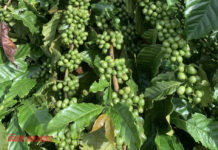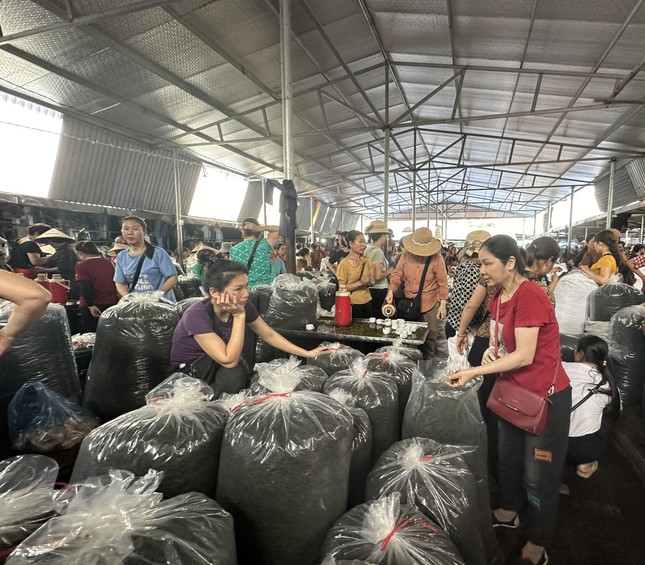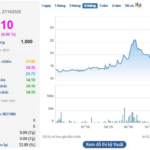Tea from Tân Cương: A Story of Heritage and Struggle
In the lush hills of Thái Nguyên, renowned for its exquisite tea, Tân Cương stands out as the premier tea-growing region. Its fertile soil and skilled artisans have crafted a reputation for producing the finest tea in the country. With a reach spanning all 63 provinces and even crossing borders, Tân Cương tea commands a premium price, reflecting its exceptional quality. The delicate “móc câu” variety typically fetches between VND 250,000–500,000 per kg, while the prized “tôm nõn” commands VND 600,000–750,000. The pinnacle, however, is the “đinh” grade, which can sell for upwards of VND 5 million per kg.
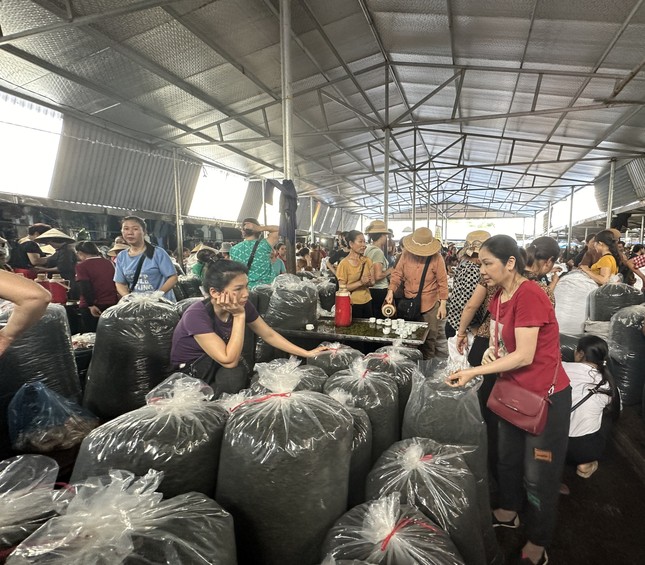
Tons of Tân Cương’s specialty tea are sold at each tea market session.
However, despite the reputation and demand, tea farmers in Tân Cương are facing a crisis. As the main harvest season begins in early May, the abundance of fresh tea leaves should herald a time of prosperity. Yet, a sudden drop in prices has left farmers reeling. Fresh tea buds that once sold for VND 35,000–40,000 per kg now struggle to reach even VND 15,000–20,000, dragging down the price of dried tea as well. “We’re drowning in losses,” lament the tea growers of Thái Nguyên, as they witness the sharp decline in their livelihoods.
The two largest tea markets, Phúc Xuân (open on the 1st, 4th, 6th, and 9th of the lunar calendar) and Phúc Trìu (open on the 2nd, 5th, 7th, and 10th), bear witness to the struggles. Tea from Tân Cương, once a sought-after commodity, now joins the fray, as its local market has mysteriously lost its buyers. Ms. Vân, a longtime tea trader from Guộc village in Tân Cương, shares her concerns. Even the finest tea from Tân Cương struggles to find buyers, let alone tea from less renowned regions. A mere VND 100,000 per kg of dried tea buds is considered a good deal, a far cry from the branded teas selling for VND 300,000–400,000.
Surrounded by piles of unsold tea and forlorn faces, Ms. Vân sighs:
“During the peak season, the supply far outstrips demand. We have no choice but to accept the low prices, as few can afford to store their tea, waiting for better days. Prices continue to plummet, from VND 150,000 to VND 120,000 per kg, and sometimes we have to settle for as low as VND 85,000. It’s heartbreaking to see how much lower they are compared to previous years.”
At each market gathering, dozens of trucks from far and wide descend upon the tea markets, hauling away some 7–10 tons of dried tea buds. Packed in large plastic bags, the tea is destined to be processed and blended, making it impossible for consumers to discern the origin or quality. Is it safe? Is it laden with pesticides? Has it been artificially colored? These questions hang in the air.
In the Tân Cương tea-growing region, numerous cooperatives and processing facilities work with local farmers to establish designated growing areas and obtain region codes. However, only a small fraction of the tea produced bears labels, packaging, or branding. The majority is sold as raw material in the village markets at half the price, or even less.
Neglecting the Legacy: The Plight of Heritage Tea Varieties
At the Phúc Xuân tea market, Ms. Hương, a tea grower from Hồng Thái 2 village in Tân Cương, stands with her basket of exquisite tea, a sight that would usually attract buyers. But today, she waits in vain. Known for producing the finest tea in all of Tân Cương, the tea from Hồng Thái 2 village is praised for its delicate, tightly curled leaves and exceptional flavor. Yet, even at a modest asking price of VND 200,000 per kg, it is deemed too expensive compared to the current market rates. Ms. Hương laments the time and effort invested in harvesting, withering, and bringing her tea to market, only to face rejection and financial loss. She confides that she is considering giving up on tea altogether if the situation persists.
Mr. Tuấn Vũ from Đồi Chè village in Phúc Trìu owns a 4,000 m2 tea garden of the TRI 777 variety, almost a decade old. Each harvest yields around 500 kg of fresh tea buds. Nestled in the heart of Núi Cốc Lake, his tea garden boasts a pristine environment and produces exceptional tea. However, when it comes time to sell, Mr. Vũ is offered only VND 70,000 per kg for dried tea buds, and even that offer is uncertain. Calculating the costs of harvesting and processing, he realizes that each harvest results in a loss of over VND 3 million. On top of that, there are expenses for pesticides and spraying, totaling more than VND 5 million per harvest. Faced with these daunting figures, Mr. Vũ has made the difficult decision to abandon his tea garden, planning to cut down the trees next month and replace them with a different crop.
The plight of Tân Cương’s tea farmers is very real. Producing high-quality tea demands significant investments in both finances and technology. With prices plummeting, not only are the farmers suffering, but the processing workshops are also struggling to stay afloat, with many already closing their doors, leaving their owners burdened with debt. The price for tea plucking has dropped from VND 20,000 per kg of fresh tea buds in previous years to a meager VND 12,000–15,000 today. Heartbroken, some farmers have resorted to hiring workers to clear their precious specialty tea bushes, forgoing the harvest altogether and neglecting their care.
Even in Nam Sơn and Guộc villages, the very birthplace of Tân Cương tea over a century ago and the source of the legendary “chè cánh hạc” that won first prize at the 1935 Hanoi Expo, launching Thái Nguyên tea to fame, the passion for tea is fading.
Mr. Nguyễn Duy Tiên, 73, the Party Secretary of Nam Sơn village, expresses his regret:
“The lack of economic viability in tea farming has driven our youth to seek work in factories. Only a handful of households continue the tradition. The tea gardens are being replaced with fruit trees or fast-growing acacia to suppress weed growth. Among those acacia groves, one can still find ancient tea trees, perhaps 50–70 years old, slowly withering away.” He reminisces about the robust flavor and lingering aftertaste of traditional Tân Cương tea, a unique quality that sets it apart from modern varieties.
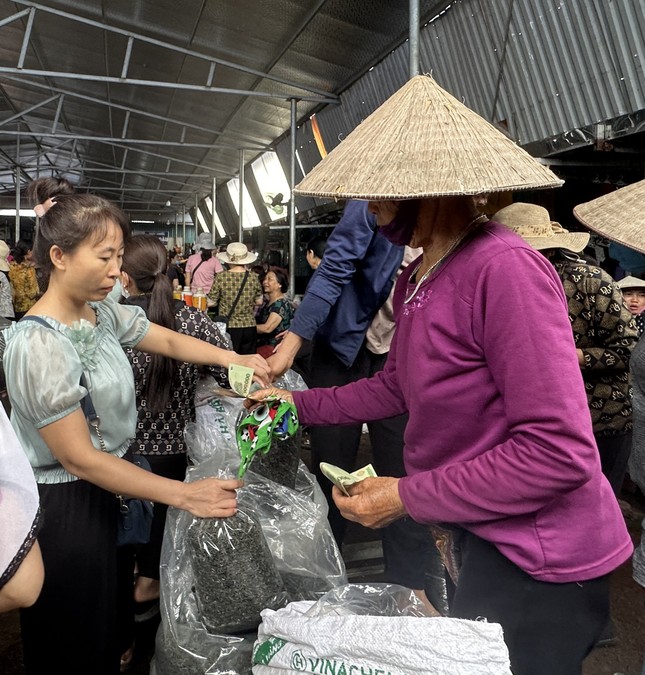
Tân Cương’s specialty tea, now selling for VND 100,000 per kg – Photo: Ý Như
Recognizing the urgency of the situation, the city of Thái Nguyên has implemented a project titled “Preservation and Development of Tân Cương Specialty Tea Region, 2021–2025.” The goal is to reach a tea-growing area of 1,700 hectares by 2025, with a yield of 155 tons of fresh tea buds per hectare and an income of over VND 1 billion per hectare. The project also aims to replace and replant at least 300 hectares with the traditional Trung Du tea variety, striving to increase its proportion to over 30% of the total area.
However, tea traders offer a different perspective. They believe that instead of expanding the tea-growing area, the focus should be on stringent quality control and securing stable markets. They emphasize the need for urgent action to inventory and preserve the ancient Trung Du tea trees, the very essence of Thái Nguyên tea, before it’s too late.

